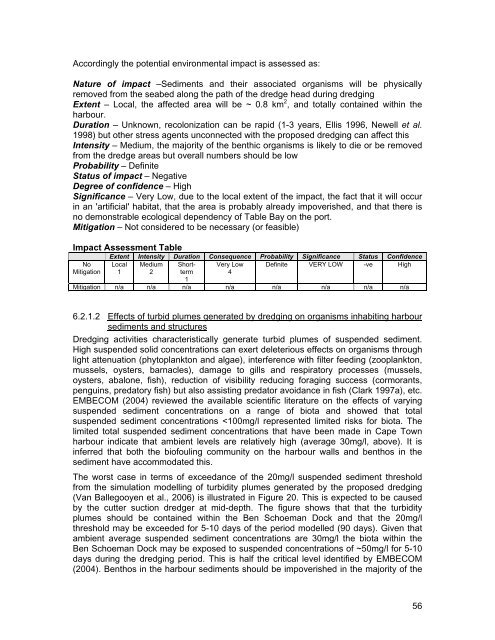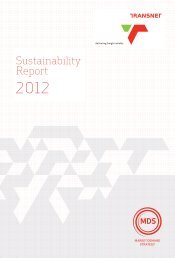BEN SCHOEMAN DOCK BERTH DEEPENING Specialist ... - Transnet
BEN SCHOEMAN DOCK BERTH DEEPENING Specialist ... - Transnet
BEN SCHOEMAN DOCK BERTH DEEPENING Specialist ... - Transnet
Create successful ePaper yourself
Turn your PDF publications into a flip-book with our unique Google optimized e-Paper software.
Accordingly the potential environmental impact is assessed as:<br />
Nature of impact –Sediments and their associated organisms will be physically<br />
removed from the seabed along the path of the dredge head during dredging<br />
Extent – Local, the affected area will be ~ 0.8 km 2 , and totally contained within the<br />
harbour.<br />
Duration – Unknown, recolonization can be rapid (1-3 years, Ellis 1996, Newell et al.<br />
1998) but other stress agents unconnected with the proposed dredging can affect this<br />
Intensity – Medium, the majority of the benthic organisms is likely to die or be removed<br />
from the dredge areas but overall numbers should be low<br />
Probability – Definite<br />
Status of impact – Negative<br />
Degree of confidence – High<br />
Significance – Very Low, due to the local extent of the impact, the fact that it will occur<br />
in an 'artificial' habitat, that the area is probably already impoverished, and that there is<br />
no demonstrable ecological dependency of Table Bay on the port.<br />
Mitigation – Not considered to be necessary (or feasible)<br />
Impact Assessment Table<br />
No<br />
Mitigation<br />
Extent Intensity Duration Consequence Probability Significance Status Confidence<br />
Local Medium Shortterm<br />
Very Low Definite VERY LOW -ve High<br />
1 2<br />
4<br />
1<br />
Mitigation n/a n/a n/a n/a n/a n/a n/a n/a<br />
6.2.1.2 Effects of turbid plumes generated by dredging on organisms inhabiting harbour<br />
sediments and structures<br />
Dredging activities characteristically generate turbid plumes of suspended sediment.<br />
High suspended solid concentrations can exert deleterious effects on organisms through<br />
light attenuation (phytoplankton and algae), interference with filter feeding (zooplankton,<br />
mussels, oysters, barnacles), damage to gills and respiratory processes (mussels,<br />
oysters, abalone, fish), reduction of visibility reducing foraging success (cormorants,<br />
penguins, predatory fish) but also assisting predator avoidance in fish (Clark 1997a), etc.<br />
EMBECOM (2004) reviewed the available scientific literature on the effects of varying<br />
suspended sediment concentrations on a range of biota and showed that total<br />
suspended sediment concentrations

















